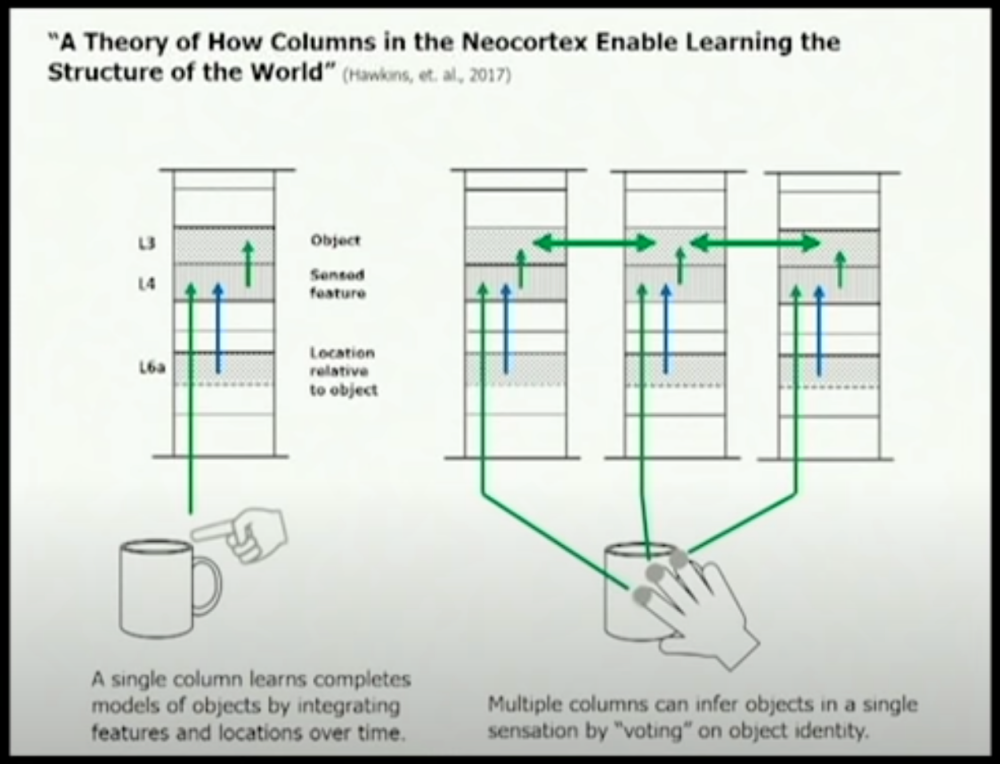
Jeff Hawkins’ [1] work advancing research on how the brain works [2] is very interesting.
He is developing a theory of how the cortex senses, computes, and models reality based on the long term research and knowledge of its layered structure [3] and cortical columns [4], which seem to be the minimal units of thought or circuits of the brain.
I have been interested not only in how and what the brain thinks, but also what it can’t think, which restrains its ability to model reality.
Hawkins’ list of learning vectors the brain may use to model reality is very useful. The vectors that the cortex units think in are:
1. Objects
2. Object location
3. Object behavior
4. They learn through movement of sensors (touch, hearing, sight, sound, and smell)
5. The objects may be physical or abstract (e.g. math, time, democracy, etc.)

How the Learning Vectors May Constrain the Brain’s View of Reality
In my opinion, the constraints these vectors impose to recreate reality are as follows:
1. The brain thinks in objects:
This means it creates positive objects only. This is why I say the absence of physical stimuli is also processed logically by the brain as meaningful objects [5].
In other words, both positive and negative objects are formed as positive objects in the cortex or in its circuits. This is a significant constraint as reality must also be made of the absence of things. This bias must be perhaps why the Heisenberg Uncertainty Principle [6] inevitably leads to quantum vacuum [7] as positive particles [8], ruling out the existence of pure vacuum.
A basic example is to think that cold is a positive object, when it is the absence of, or reduced kinetic energy.
2. Object location:
Perhaps due to the Pauli Exclusion Principle [9] and fermions [10], matter, thus the brain with its cortex and circuits, is possible. But also space, volume, and location are possible in general.
It seems the brain creates the objects in point 1 above, and inevitably needs to give them a location as well, as Hawkins says. I would argue, due to Dunbar kind of constraints [11], it also gives them personhood.
In other words, the brain treats all objects as positive, and it gives them personhood. Examples may be thoughts like “this cold weather is nasty”, “my motherland is France”, or “I am going to beat this evil disease”.
The same also works with collectives, even though they are abstractions: “my school says X”, “the country voted for Y candidate”, etc.
3. Object behavior:
Behavior is perhaps a proxy for action. This is why we think of photons as quanta of action [12], even though we know that, due to time dilation [13], they are actually static, or in absolute rest [14].
Action of fermions at a macro scale is motion of objects across distance, behavior of organisms, and other behavior. It is interesting that due to these first three vectors, the brain thinks of a quantum of vacuum as a positive object and that it must have action.
But reality may be that a quantum of vacuum is a non object and the absolute absence of action. In fact, without a true quantum of vacuum a quantum of action (thus space and volume in general) would not be possible.
This is why I speculate that the Heisenberg Uncertainty Principle, with respect to vacuum, is a bias and must erroneously lead to the belief that quantum particles appear in vacua out of nothingness. Thus, violating the law of conservation of energy.
4. Cortical column learning is through the movement of sensors:
Below I will say why I think this is not complete, but it is a constraint as it means that with no motion there must be no learning.
The condition of movement of sensors must be linked to the vector of location; that we give a three dimensional positive personhood to objects; and that they must have some sort of behavior through action.
5. Objects can be physical or abstract:
I think this is a key anti-constraint because the brain can imagine a wide range of abstract objects such as God, math equations, democracy, engage in predictions, and more.
However, we cannot imagine physical space in more than three dimensions, it’s difficult to imagine particles as waves and particles [15], and so on. In this case, abstraction does not escape from the physical constraints.
I think this is because, even in complete abstraction, we are constrained by the vectors above and this makes us imagine all abstract objects as positive, many times with personhood, and with some sort of behavior.
Abstractions Are Recycled as Input
As to why learning in point 4 is only through movement of sensors is incomplete*, I think if learning were only through sensors and physical movement, then the brain would not imagine equations, for example.
However, in practice objects created in abstraction must be recycled as input for further creation of more abstract objects.
For example; the abstractions of distance and time are recycled to create a ratio which is the abstraction of speed; then, we add direction (perhaps related to the location ability of the cortex) and we create the abstraction of velocity; we overlap velocity again with time and we create the abstraction of acceleration; we theoretically accelerate objects and we reach the concept of the speed of light; and so on.
All of the above are not movements that were captured by the senses but purely mental operations that were recycled internally. Perhaps, not even processed by sensory neurons.
Conclusion
All of the above must obviously be for evolutionary reasons. I am sure many animals can perceive things humans don’t, and even have some learning vectors that we don’t (e.g. more or different colors and sounds, ability to see smaller or farther away things, think in negative as well as positive objects, etc.)
One thing I think is important to include in Hawkins’ models, is the limitation of the brain to compute in parallel from 3 to 6 objects at a time [16]. This is likely due to basal ganglia [17] and perhaps thalamus [18] constraints to manage thought traffic (a sort of brain bandwidth limitation). Therefore, the need to drop some thoughts to prioritize others [19].
This is what leads to constraints in higher order thinking, and we can generally think only up to 4 to 6 levels of intentionality [20], and even the most famous equations are generally limited to 3 to 6 terms (e.g. E = MC2 is 3 terms, and Schrödinger’s equation is 5 terms: i, h-bar, psi , t, and the Hamiltonian operator).
All this imposes a constraint for understanding complexity. This is why we think of information, energy, time, space, justice, money, love, and other abstractions as positive things. Some with personhood and fully anthropomorphized, even though they are mere mental constructs.
Finally, another class of constraints may be all the objects and events not capturable by the senses, such as the rest of the electromagnetic spectrum outside of visible light [21], small things like neutrinos [22], etc.
If cortical columns depend on sensory input, and abstractions can only be created responding to these vectors, thus imitating physical sensory inputs and behavior, then there must exist many types of interactions, other than those sensory inputs we do feel, that we are not catching.
Perhaps, we not only need to study these things more, but also evolve some more “post-neocortex” sections in our brain to have a more complete view of reality.
I always say that if God exists and he is really omniscient, omnipresent, omnipotent, and omnitemporal then he must have a brain the size of half the universe so he can think about and control the other half!
*Nota Bene: Jeff Hawkins clarifies further in this video on YouTube from 2018 that, by objects and movements of sensors, cortical columns learn how to model reality, but that they also use the same in abstraction. This means that my objection above under the title “Abstractions are Recycled as Input” is correct conceptually, but he had not excluded that concept from his theory as I incorrectly assumed:
https://youtu.be/zVGQeFFjhEk?t=2020
References
[1] Jeff Hawkins – by Wikipedia: https://en.wikipedia.org/wiki/Jeff_Hawkins
[2] Jeff Hawkins at the Johns Hopkins APL Colloquium Series – “A framework for understanding how the neocortex works” – Numenta on YouTube: https://youtu.be/pmIs9Eh08gA
[3] Layers of the neocortex – by Wikipedia: https://en.wikipedia.org/wiki/Cerebral_cortex#Layers_of_neocortex
[4] Cortical columns – by Wikipedia: https://en.wikipedia.org/wiki/Cortical_column
[5] What is Information? – by Donald McIntyre: https://etherplan.com/2020/11/02/what-is-information/13378/
[6] Heisenberg Uncertainty Principle – by Wikipedia: https://en.wikipedia.org/wiki/Uncertainty_principle
[7] Quantum vacuum state – by Wikipedia: https://en.wikipedia.org/wiki/Quantum_vacuum_state
[8] Quantum fluctuation – by Wikipedia: https://en.wikipedia.org/wiki/Quantum_fluctuation
[9] Pauli Exclusion Principle: https://en.wikipedia.org/wiki/Pauli_exclusion_principle
[10] Fermion – by Wikipedia: https://en.wikipedia.org/wiki/Fermion
[11] Dunbar’s Number – by Wikipedia: https://en.wikipedia.org/wiki/Dunbar’s_number
[12] Planck’s constant – by Wikipedia: https://en.wikipedia.org/wiki/Planck_constant
[13] Time dilation – by Wikipedia: https://en.wikipedia.org/wiki/Time_dilation
[14] The Speed of Light is Absolute Rest, not Motion – by Donald McIntyre: https://etherplan.com/2020/10/22/the-speed-of-light-is-absolute-rest-not-motion/13306/
[15] Wave – particle duality – by Wikipedia: https://en.wikipedia.org/wiki/Wave-particle_duality
[16] Using Genetics and Brain Capacity to Model Reality – by Donald McIntyre: https://etherplan.com/2020/10/08/using-genetics-and-brain-capacity-to-model-reality/12920/
[17] Basal ganglia – by Wikipedia: https://en.wikipedia.org/wiki/Basal_ganglia
[18] Thalamus – by Wikipedia: https://en.wikipedia.org/wiki/Thalamus
[19] Basal ganglia action selection – by Scholarpedia, curated by Tony J. Prescott: http://www.scholarpedia.org/article/Action_selection#The_basal_ganglia
[20] Higher order intentionality tasks are cognitively more demanding – by Penelope A. Lewis, Amy Birch, Alexander Hall, and Robin I. M. Dunbar: https://www.ncbi.nlm.nih.gov/pmc/articles/PMC5490680/
[21] Electromagnetic spectrum – by Wikipedia: https://en.wikipedia.org/wiki/Electromagnetic_spectrum
[22] Neutrinos – by Wikipedia: https://en.wikipedia.org/wiki/Neutrino